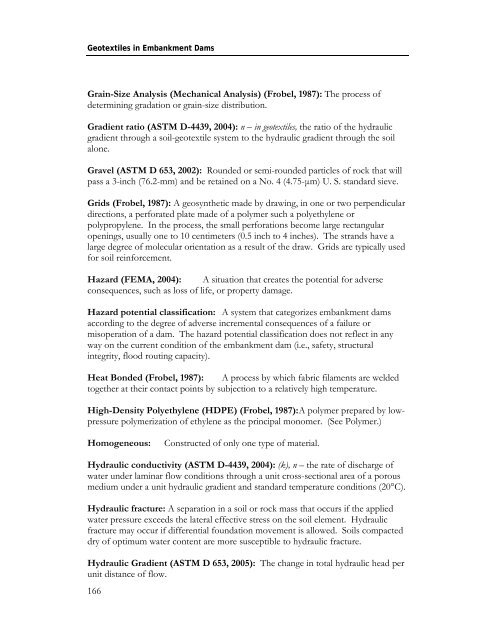Geotextiles in Embankment Dams - Association of State Dam Safety ...
Geotextiles in Embankment Dams - Association of State Dam Safety ...
Geotextiles in Embankment Dams - Association of State Dam Safety ...
You also want an ePaper? Increase the reach of your titles
YUMPU automatically turns print PDFs into web optimized ePapers that Google loves.
<strong>Geotextiles</strong> <strong>in</strong> <strong>Embankment</strong> <strong><strong>Dam</strong>s</strong>Gra<strong>in</strong>-Size Analysis (Mechanical Analysis) (Frobel, 1987): The process <strong>of</strong>determ<strong>in</strong><strong>in</strong>g gradation or gra<strong>in</strong>-size distribution.Gradient ratio (ASTM D-4439, 2004): n – <strong>in</strong> geotextiles, the ratio <strong>of</strong> the hydraulicgradient through a soil-geotextile system to the hydraulic gradient through the soilalone.Gravel (ASTM D 653, 2002): Rounded or semi-rounded particles <strong>of</strong> rock that willpass a 3-<strong>in</strong>ch (76.2-mm) and be reta<strong>in</strong>ed on a No. 4 (4.75-μm) U. S. standard sieve.Grids (Frobel, 1987): A geosynthetic made by draw<strong>in</strong>g, <strong>in</strong> one or two perpendiculardirections, a perforated plate made <strong>of</strong> a polymer such a polyethylene orpolypropylene. In the process, the small perforations become large rectangularopen<strong>in</strong>gs, usually one to 10 centimeters (0.5 <strong>in</strong>ch to 4 <strong>in</strong>ches). The strands have alarge degree <strong>of</strong> molecular orientation as a result <strong>of</strong> the draw. Grids are typically usedfor soil re<strong>in</strong>forcement.Hazard (FEMA, 2004): A situation that creates the potential for adverseconsequences, such as loss <strong>of</strong> life, or property damage.Hazard potential classification: A system that categorizes embankment damsaccord<strong>in</strong>g to the degree <strong>of</strong> adverse <strong>in</strong>cremental consequences <strong>of</strong> a failure ormisoperation <strong>of</strong> a dam. The hazard potential classification does not reflect <strong>in</strong> anyway on the current condition <strong>of</strong> the embankment dam (i.e., safety, structural<strong>in</strong>tegrity, flood rout<strong>in</strong>g capacity).Heat Bonded (Frobel, 1987): A process by which fabric filaments are weldedtogether at their contact po<strong>in</strong>ts by subjection to a relatively high temperature.High-Density Polyethylene (HDPE) (Frobel, 1987): A polymer prepared by lowpressurepolymerization <strong>of</strong> ethylene as the pr<strong>in</strong>cipal monomer. (See Polymer.)Homogeneous:Constructed <strong>of</strong> only one type <strong>of</strong> material.Hydraulic conductivity (ASTM D-4439, 2004): (k), n – the rate <strong>of</strong> discharge <strong>of</strong>water under lam<strong>in</strong>ar flow conditions through a unit cross-sectional area <strong>of</strong> a porousmedium under a unit hydraulic gradient and standard temperature conditions (20°C).Hydraulic fracture: A separation <strong>in</strong> a soil or rock mass that occurs if the appliedwater pressure exceeds the lateral effective stress on the soil element. Hydraulicfracture may occur if differential foundation movement is allowed. Soils compacteddry <strong>of</strong> optimum water content are more susceptible to hydraulic fracture.Hydraulic Gradient (ASTM D 653, 2005): The change <strong>in</strong> total hydraulic head perunit distance <strong>of</strong> flow.166
















